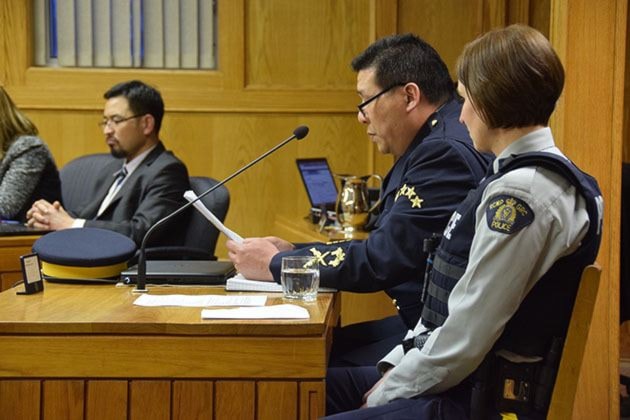Cranbrook RCMP delivered year-end crime statistics to Cranbrook council on Monday evening, while also touting the success of their new mental health liaison officer who has been able to help cut down the volume of mental health calls.
S/Sgt. Hector Lee reported that most crime statistics are down across the board except for motor vehicle accidents (MVA), alcohol involved MVA’s and impaired driving.
MVAs are up 17 per cent over 2015, while the alcohol-involved percentage of those MVAs is up by a single percentage point over last year.
Additionally, impaired/refusal and Immediate Roadside Prohibitions are up 16 per cent.
“I think overall, we see a lot higher form of diligence from our officers at these scenes,” Lee said. “I think they’re better at detecting alcohol, better at processing scenes and better at investigating when it comes to motor vehicle accidents which is contributing to a higher [statistical] number overall.”
Lee also acknowledges the MVA stats may be a little off as not all accidents are reported to police.
“People go to ICBC right away, sometimes they don’t come to the police,” Lee said. “So to get a true and accurate number, our plan is to go to ICBC and see what their numbers are and see what their trend is as well.”
Total calls for service were up seven per cent in the Q4, while year-end calls were relatively unchanged from 2015 at 8,267.
Person offences — assaults, sex assaults, assault with a weapon, robbery, threats, criminal harassment — was down 26 per cent in the quarter and 10 per cent from 2015.
Property offences were down two per cent, however, there was a rash of 20 break and enters over the last quarter.
“We were actually trending downward very much right after the end of the summer,” Lee said. “There were at least three different crime groups that we were able to thwart before they actually got going and that drove our property offences down.
“Then September happened after a busy summer. We had a crime group wreaked havoc on us in the quarter drove our stats back up, so I’m hoping for a little bit more even approach for this fall and the coming year in keeping our property crimes down.”
Other criminal code offences such as causing a disturbance, breach/bail violations, firearms offences, public mischief, obstructing a police officer and counterfeit currency were up 34 per cent in the quarter, but down three per cent at year-end.
There were less drug files than last year at 91, however, the clearance rate improved to 74 files at rate of 79 per cent.
Total criminal code files was 1,506 with 624 cleared, for a rate of 41 per cent. There were 104 fewer criminal code files in 2016 than there were in 2015.
Issued traffic tickets were down by 30 per cent, however, warnings were up by 78 per cent.
Mental Health Liaison
Lee praised the work of Cst. Erin Stevenson, who moved into a mental health liasion position last October to help deal with a steadily increasing amount of mental health files.
“I think it’s important to note that as a result of Erin’s work just in the short few months she’s been in the position that our mental health calls for service have actually come down,” said Lee, “and a lot of it has to do with the partnerships she’s developed and just looking for a more effective way to deal with mental health-related incidents.”
Since she began working in the new position, Stevenson has met with 17 other non-profits and organizations to find and build on partnerships to tackle mental health issues and reduce the volume of calls for the RCMP.
“ People are very excited this position exists, they do contact me fairly regularly,” Stevenson said. “…The ER was one of the big reasons why Hector decided this position was needed. A lot of our officers were spending a lot of time at the ER doing an MHA [Mental Health Act] apprehension and go to the hospital and spend up to 11 hours up there.
“We’re still working with the ER, but right now my focus has been to redirect from the ER, so if it’s during the daytime, we have Interior Health mental health who can help us with assessments.”
Other opportunities have included bringing front-line emergency responders together such as RCMP, firefighters and paramedics for additional training on recognizing if a patient or suspect requires mental health or child and family development services.
“We see so much of it, sometimes we’re immune to it…it’s one phone call,” Stevenson said. “That intake worker can go visit the home, they can call them and at least they can get some help. It doesn’t mean they will take the help, that’s the one thing, especially if they’re adults. If they don’t want the help, they don’t have to take it, but at least we’ve made that connection. That was a really positive meeting.”
City councillor Norma Blissett said the mental health liaison position is proving it’s worth.
“We’re saving money not only for the RCMP, but also for the hospital,” she said, “and we’re keeping people out of the penal system. It’s a great model and I’m really pleased that we’re doing this because sick people don’t need to be in jail, they need to be treated and it’s great that you’re able to help them.”
